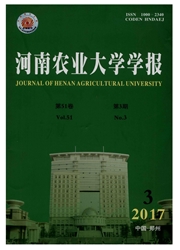

 中文摘要:
中文摘要:
在现在的学习, zooblooting, ELISA,和整个山的免疫细胞化学,方法被用来从日本橡树蚕识别 FXPRLamide 家庭 neuropeptides, Antheraea yamamai。结果出现了从 A 的 genomic 脱氧核糖核酸。yamamai 在是有从 Samia 月之女神篦麻毒素 i 的 DH-PBAN cDNA 的碎片的 hybridized 以后给积极乐队看了,它用被标记[α - 32P ]-dCTP。SG 在神经机关显示出最高的 FXPRLamide 肽效价。用对 Helicoverpa 有佩带徽章权利的人的抗血清 PBAN,象 PBAN 一样免疫反应在 A 的 SG 和 TG 被检测。由整个山的免疫细胞化学的 yamamai,并且在显示出积极象 PBAN 一样免疫的 SG 有三个簇房间反应。在血淋巴的 FXPRLamide 肽免疫反应的乳头 ers 在稳定的水平被保留。在化蛹期间,效价即时被增加,但是然后在早蛹的阶段以后减少了到底层。上述结果在 A 表明 FXPRLamide 家庭肽的存在。yamamai,而是它的功能需要以后进一步被调查。
 英文摘要:
英文摘要:
In the present study, zooblooting, ELISA, and whole-mount immunocytochemistry methods were used to identify the FXPRLamide family neuropeptides from the Japanese oak silkworm, Antheraea yamamai. The results showed that the genomic DNA from A. yamamai showed positive bands after being hybridized with the fragment of DH-PBAN cDNA from Samia cynthia ricini, which was labeled with [α-32p]-dCTP. The SG showed highest FXPRLamide peptides titer in neural organs. Using an antiserum against Helicoverpa armigera PBAN, PBAN-like immunoreactivity was detected in the SG and TG of A. yamamai by whole-mount immunocytochemistry, and there were three cluster cells in the SG which shows positive PBAN-like immunoreactivity. The titers of FXPRLamide peptides immunoreactivity in the hemolymph were kept at a steady level. During pupation, the titer was increased promptly, but then decreased to a low level after the early pupal stage. The above-mentioned results demonstrate the existence of FXPRLamide family peptides in A. yamamai, but its function needs to be further investigated in the future.
 同期刊论文项目
同期刊论文项目
 同项目期刊论文
同项目期刊论文
 Characters and expression of the gene encoding DH, PBAN and other FXPRLamide family neuropeptides in
Characters and expression of the gene encoding DH, PBAN and other FXPRLamide family neuropeptides in DNA damage by the cobalt (II) and zinc (II) complexes of tetraazamacrocyclic in Tetrahymena thermoph
DNA damage by the cobalt (II) and zinc (II) complexes of tetraazamacrocyclic in Tetrahymena thermoph 期刊信息
期刊信息
